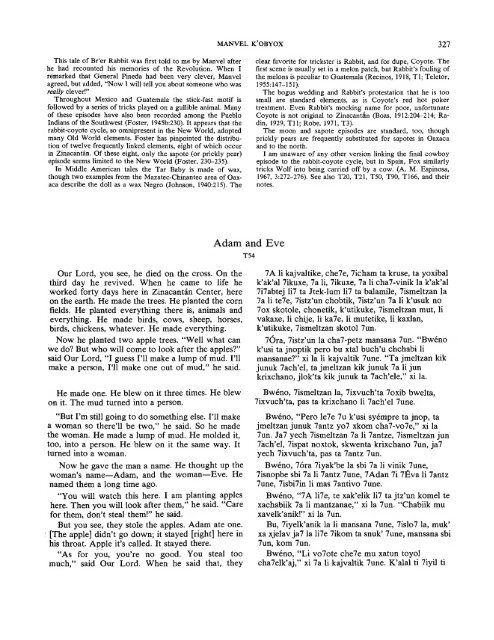PDF (Lo-Res) - Smithsonian Institution Libraries
PDF (Lo-Res) - Smithsonian Institution Libraries
PDF (Lo-Res) - Smithsonian Institution Libraries
You also want an ePaper? Increase the reach of your titles
YUMPU automatically turns print PDFs into web optimized ePapers that Google loves.
This tale of Br'er Rabbit was first told to me by Manvel after<br />
he had recounted his memories of the Revolution. When I<br />
remarked that General Pineda had been very clever, Manvel<br />
agreed, but added, "Now I will tell you about someone who was<br />
really clever!"<br />
Throughout Mexico and Guatemala the stick-fast motif is<br />
followed by a series of tricks played on a gullible animal. Many<br />
of these episodes have also been recorded among the Pueblo<br />
Indians of the Southwest (Foster, 1945b:230). It appears that the<br />
rabbit-coyote cycle, so omnipresent in the New World, adopted<br />
many Old World elements. Foster has pinpointed the distribution<br />
of twelve frequently linked elements, eight of which occur<br />
in Zinacantan. Of these eight, only the sapote (or prickly pear)<br />
episode seems limited to the New World (Foster, 230-235).<br />
In Middle American tales the Tar Baby is made of wax,<br />
though two examples from the Mazatec-Chinantec area of Oaxaca<br />
describe the doll as a wax Negro (Johnson, 1940:215). The<br />
Our <strong>Lo</strong>rd, you see, he died on the cross. On the<br />
third day he revived. When he came to life he<br />
worked forty days here in Zinacantan Center, here<br />
on the earth. He made the trees. He planted the corn<br />
fields. He planted everything there is, animals and<br />
everything. He made birds, cows, sheep, horses,<br />
birds, chickens, whatever. He made everything.<br />
Now he planted two apple trees. "Well what can<br />
we do? But who will come to look after the apples?"<br />
said Our <strong>Lo</strong>rd, "I guess I'll make a lump of mud. I'll<br />
make a person, I'll make one out of mud," he said.<br />
He made one. He blew on it three times. He blew<br />
on it. The mud turned into a person.<br />
"But I'm still going to do something else. I'll make<br />
a woman so there'll be two," he said. So he made<br />
the woman. He made a lump of mud. He molded it,<br />
too, into a person. He blew on it the same way. It<br />
turned into a woman.<br />
Now he gave the man a name. He thought up the<br />
woman's name—Adam, and the woman—Eve. He<br />
named them a long time ago.<br />
"You will watch this here. I am planting apples<br />
here. Then you will look after them," he said. "Care<br />
for them, don't steal them!" he said.<br />
But you see, they stole the apples. Adam ate one.<br />
[The apple] didn't go down; it stayed [right] here in<br />
his throat. Apple it's called. It stayed there.<br />
"As for you, you're no good. You steal too<br />
much," said Our <strong>Lo</strong>rd. When he said that, they<br />
MANVEL K'OBYOX 327<br />
Adam and Eve<br />
T54<br />
clear favorite for trickster is Rabbit, and for dupe, Coyote. The<br />
first scene is usually set in a melon patch, but Rabbit's fouling of<br />
the melons is peculiar to Guatemala (Recinos, 1918, Tl; Teletor,<br />
1955:147-151).<br />
The bogus wedding and Rabbit's protestation that he is too<br />
small are standard elements, as is Coyote's red hot poker<br />
treatment. Even Rabbit's mocking name for poor, unfortunate<br />
Coyote is not original to Zinacantan (Boas, 1912:204-214; Radin,<br />
1929, Til; Robe, 1971, T3).<br />
The moon and sapote episodes are standard, too, though<br />
prickly pears are frequently substituted for sapotes in Oaxaca<br />
and to the north.<br />
I am unaware of any other version linking the final cowboy<br />
episode to the rabbit-coyote cycle, but in Spain, Fox similarly<br />
tricks Wolf into being carried off by a cow. (A. M. Espinosa,<br />
1967, 3:272-276). See also T20, T21, T50, T90, T166, and their<br />
notes.<br />
7A li kajvaltike, che7e, 7icham ta kruse, ta yoxibal<br />
k'ak'al 7ikuxe, 7a li, 7ikuxe, 7a li cha7-vinik la k'ak'al<br />
7i7abtej H7 ta Jtek-lum H7 ta balamile, 7ismeltzan la<br />
7a li te7e, 7istz'un chobtik, 7istz'un 7a li k'usuk no<br />
7ox skotole, chonetik, k'utikuke, 7ismeltzan mut, li<br />
vakaxe, li chije, li ka7e, li mutetike, li kaxlan,<br />
k'utikuke, 7ismeltzan skotol 7un.<br />
7Ora, 7istz'un la cha7-petz mansana 7ur_. "Bweno<br />
k'usi ta jnoptik pero bu xtal buch'u chchabi li<br />
mansanae?" xi la li kajvaltik 7une. "Ta jmeltzan kik<br />
junuk 7ach'el, ta jmeltzan kik junuk 7a li jun<br />
krixchano, jlok'ta kik junuk ta 7ach'ele," xi la.<br />
Bweno, 7ismeltzan la, 7ixvuch'ta 7oxib bwelta,<br />
7ixvuch'ta, pas ta krixchano li 7ach'el 7une.<br />
Bweno, "Pero Ie7e 7u k'usi syempre ta jnop, ta<br />
jmeltzan junuk 7antz yo7 xkom cha7-vo7e," xi la<br />
7un. Ja7 yech 7ismeltzan 7a li 7antze, 7ismeltzan jun<br />
7ach'el, 7ispat noxtok, skwenta krixchano 7un, ja7<br />
yech 7ixvuch'ta, pas ta 7antz 7un.<br />
Bweno, 76ra 7iyak'be la sbi 7a li vinik 7une,<br />
7isnopbe sbi 7a li 7antz 7une, 7Adan 7i 7Eva li 7antz<br />
7une, 7isbi7in li mas 7antivo 7une.<br />
Bweno, "7A Ii7e, te xak'elik Ii7 ta jtz'un komel te<br />
xachabiik 7a li mantzanae," xi la 7un. "Chabiik mu<br />
xavelk'anik!" xi la 7un.<br />
Bu, 7iyelk'anik la li mansana 7une, 7islo7 la, muk'<br />
xa xjelav ja7 la Ii7e 7ikom ta snuk' 7une, mansana sbi<br />
7un, kom 7un.<br />
Bweno, "Li vo7ote che7e mu xatun toyol<br />
cha7elk'aj," xi 7a li kajvaltik 7une. K'alal ti 7iyil ti

















